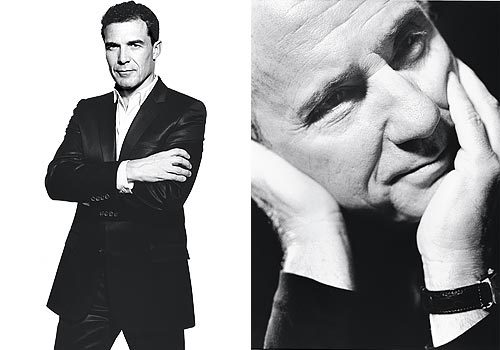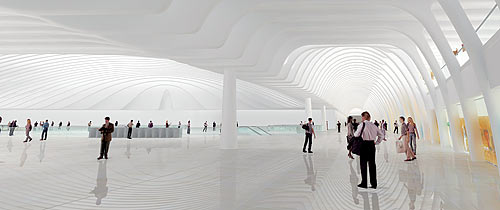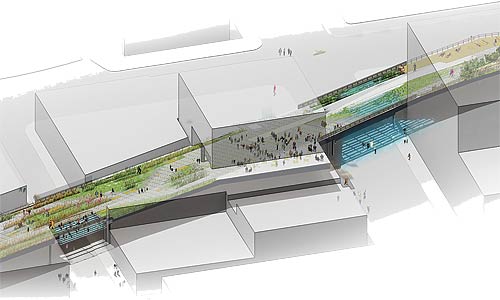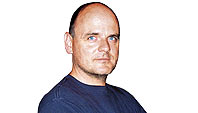
André Balazs and Ian Schrager
Hoteliers turned developers
Together, they polished downtown to a lustrous sheen. Their hotels became blueprints for modern luxe living (when Rupert Murdoch decided to relocate downtown, he hired Balazs’s Mercer Hotel designer), and both are expanding in every direction. Balazs is building two new hotels on the High Line, plus a ground-up condo way downtown (William and Beaver Streets), the next refuge for hipster families. Schrager has 40 Bond, the Herzog & de Meuron project that out-Sohos Soho, plus the even more precious Gramercy Park Hotel and residences. The Lewis and Clark of high-bourgeois style.
Richard Meier
Architect
One word: glass. Thanks to Meier’s chic, glassy towers at 173 and 176 Perry Street, no developer can get enough of it. Good or bad, up and down the waterfronts, through midtown, and into the boroughs, the city is turning into a crystal canyon.
Douglas Durst
Co-president, the Durst Organization
If New York finally goes green, it will be because of one building: One Bryant Park, developed by Durst and designed by architects Cook + Fox, is shaped like a set of sails and equipped with its own natural-gas power plant, waterless urinals, and air-conditioning on ice. Durst became a sustainable pioneer when he developed the greenish 4 Times Square in 1999, but he’s deepening his commitment with the new Bank of America building, which is expected to earn the highest possible environmental rating when it’s finished in 2008.
Keith Bomely
Creative director of architectural visualizations, Dbox
In the past few years, architecture has become the sexiest of arts. Keith Bomely and his colleagues at Dbox are its pornographers. Passion for the city’s new construction is inspired not by an actual building, or even an old-fashioned 3-D model, but a rendering. And in all likelihood, Dbox (whose clients include Richard Meier, Skidmore, Owings & Merrill, and Sir Norman Foster) made that rendering. The multimedia firm is the real architect of our real-estate dreams, enticing buyers, wooing developers, and convincing critics that some building five years out is worthy of our skyline.

Santiago Calatrava
Architect
Whether you think his metaphorical shapes—birds, torsos, eyes—are gimmicky or inspired, there is no denying that Calatrava is having a major impact on the city’s skyline—and its infrastructure. Even if the South Street tower of cubes never gets built, it will expand the idea of what’s possible to build in New York. And we will always have the WTC Transportation Hub—the only good architecture, so far, at ground zero—and perhaps the elegant, etiolated tram to Governors Island.
Robert A.M. Stern
Dean, Yale School of Architecture
There will never be another Philip Johnson, but the upper echelons of the architecture world still like a club. Lately, the best approximation has been the Yale School of Architecture, transformed by Stern into a place where Frank Gehry, Peter Eisenman, and Will Bruder teach alongside younger stars like Greg Lynn and Jeanne Gang. Cheerfully offering martinis, and successful enough not to care that few of his guests like his architectural work, Stern is a powerhouse host, one who has shifted the city’s architectural center a little bit to the north.
Murray Moss
Founder, Moss
Moss brokered the marriage of the store and the museum—mostly to the benefit of both. One can’t help but think of his white-on-white Greene Street store when checking out the display cases at MoMA. And his whim alone is enough to make a trend. Who sold us on all-white china? Embroidered vases? Laser-cut flowers? The mid-century colonization of Soho—all those look-alike shops, selling the same plastic/clean-lined/streamlined products on adjacent blocks—would have been impossible without Moss’s lead. But he’s still the only one who can elevate the store to a work of art.
James Zemaitis
Director, Twentieth-Century Design Department, Sotheby’s
The Sotheby’s tastemaker is extending the obsession with twentieth-century design into the 21st by beginning the canonization of younger designers a mere two or three or ten years after they’ve issued an iconic piece. A teddy-bear chair by the Brazilian Campana brothers, for example, sold for $66,000, just a few years after Moss had it new for $18,000. A prototype of Mark Newson’s 1985 Lockheed Lounge—an icon at age 21—is his latest score. For those of us not interested in five- to-seven-figure furniture, the trickle-down effect is mostly in reissues: After pieces like Jean Prouvé’s Cité armchair started selling for $100,000, Vitra reissued his work (that chair for $2,800). Architecture & Design: The Annotated High Line
The Annotated High Line

All roads in New York architecture lead to the High Line, the greenest, hippest, most-watched urban transformation in the city—one and a half elevated miles of concrete planks, mini-meadows, and sundecks. The park won’t open until summer 2008, but it has already had a stunning impact on the adjacent blocks, where a forest of 27 new residential towers, hotels, offices, and museums, is rising.

Joshua David and Robert Hammond
Co-founders, Friends of the High Line
Through determination, networking, and good design, they turned a crazy idea into something a podium full of politicians wants to take credit for. Now they’ve become pinups for grassroots dreamers—a new Globe Theatre on Governors Island? A greenway around the Bronx? Maybe, with a little help from powerful friends.

James Corner
Principal, Field Operations
With his designs for the High Line and, even more important, Fresh Kills, Corner is turning pieces of the man-made world back into open meadows, forest glens, and wetland habitats. His work is rough, apparently natural, and ecologically sound, something like Frederick Law Olmsted’s but unmowed and unfenced. It’s what parks are going to look like for the next 25 years.

Elizabeth Diller, Ric Scofidio, Charles Renfro
Principals, Diller Scofidio + Renfro
Long known for their high-concept installations and theoretical work, this local firm beat out international heavy hitters to win the High Line project by introducing a radically new language for New York’s streetscapes: curves and dips that create mystery and drama rather than prettiness and nostalgia.

Amanda Burden
Chair, City Planning Commission
Many city officials had a hand in the High Line. But it was Burden who realized the park’s transformative potential not just for the tracks but for the neighborhoods they link: the meatpacking district, Chelsea, and Hudson Yards. She championed a creative rezoning of the area, which insists that new buildings defer to the park’s primacy and ensures development of affordable housing. Next: The Influentials in Books